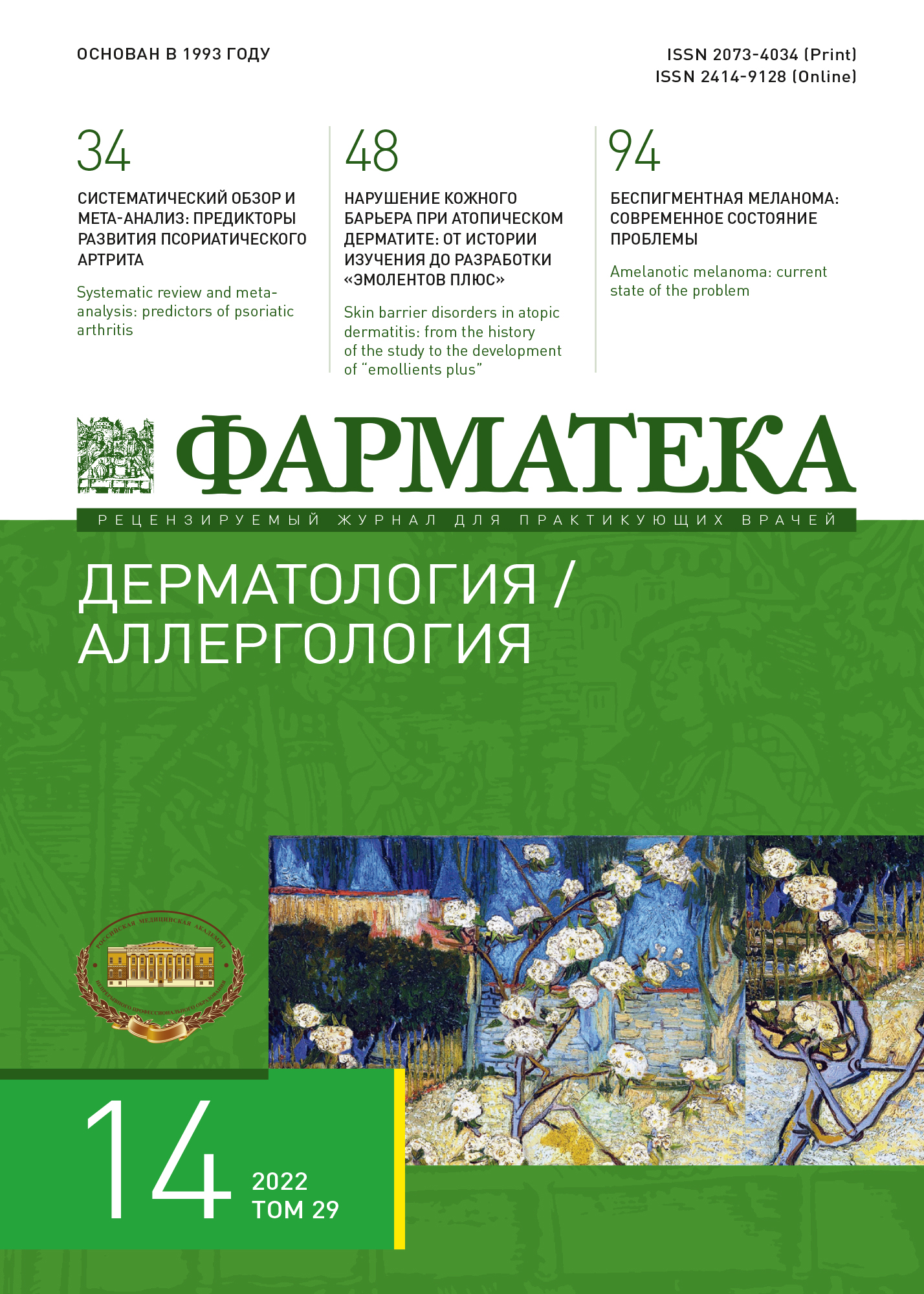Вторичное инфицирование при аллергодерматозах, многообразие форм и индивидуальный выбор терапии
- Авторы: Тамразова О.Б1,2, Стадникова А.С1,2, Таганов А.В1, Глухова Е.А1, Сухотина А.Г1, Садовникова А.М1
-
Учреждения:
- Российский университет дружбы народов
- Детская городская клиническая больница им. З.А. Башляевой ДЗМ
- Выпуск: Том 29, № 14 (2022)
- Страницы: 82-90
- Раздел: Статьи
- Статья опубликована: 20.12.2022
- URL: https://journals.eco-vector.com/2073-4034/article/view/321164
- DOI: https://doi.org/10.18565/pharmateca.2022.14.82-90
- ID: 321164
Цитировать
Полный текст
Аннотация
Полный текст
Об авторах
О. Б Тамразова
Российский университет дружбы народов; Детская городская клиническая больница им. З.А. Башляевой ДЗМ
А. С Стадникова
Российский университет дружбы народов; Детская городская клиническая больница им. З.А. Башляевой ДЗМ
А. В Таганов
Российский университет дружбы народов
Е. А Глухова
Российский университет дружбы народов
А. Г Сухотина
Российский университет дружбы народов
А. М Садовникова
Российский университет дружбы народов
Список литературы
- Gordon S. Ellie Metchnikoff: Father of natural immunity. Eur J Immunol. 2008;38:3257-64. doi: 10.1002/eji.200838855.
- Lin YT, Wang CT, Chiang B.L Role of bacterial pathogens in atopic dermatitis. Clin Immunol Rev Allergy. 2007;33(3):167-77. Doi: 10.1007/ S12016-007-0044-5.
- Nakamura Y., Oscherwitz J., Nunez G., et al. Staphylococcus delta-toxin induces allergic skin disease by activating mast cells. Nature. 2013;503:397-401. doi: 10.1038/nature12655.
- Тамразова О.Б., Новосельцев М.В. Экзематозные поражения кистей рук. Вестник дерматологии и венерологии. 2016;(1):85-92. [Tamrazova O.B., Novosel'tsev M.V. Eczematous lesions of the hands. Vestnik dermatologii i venerologii. 2016;(1):85-92. (In Russ.)].
- Nutten S. Atopic dermatitis: global epidemiology and risk factors. Ann Nutr Metab. 2015;66(Suppl. 1):8-16. doi: 10.1159/000370220.
- Тамразова О.Б., Молочков А.В., Тебеньков А.В. Особенности терапии сочетанных дерматозов у детей. Клиническая дерматология и венерология. 2012;10(3):47-52.
- Ong PY, et al: Endogenous antimicrobial peptides and skin infections in atopic dermatitis. N Engl J Med. 2002;347:1151. doi: 10.1056/NEJMoa021481.
- Williams R.E.A. The Antibacterial-Corticosteroid Combination. Am J Clin Dermatol. 2000;(1):211-15 doi: 10.2165/00128071-200001040-00002.
- Львов А.Н. Пропедевтические основы комбинированной наружной терапии при дерматозах сочетанной этиологии. Клиническая дерматология и венерология. 2016;1:78-84.
- Alexander H., Paller A.S., Traidl-Hoffmann C., et al. The role of bacterial skin infections in atopic dermatitis: expert statement and review from the International Eczema Council Skin Infection Group. Br J Dermatol. 2020;182(6):1331-42. Doi: 10.1111/ bjd.18643.
- Benenson S., Zimhony O., Dahan D., et al. Atopic dermatitis - a risk factor for invasive Staphylococcus aureus infections: two cases and review. Am J Med. 2005;118:1048-51. Doi: 10.1016/j. amjmed.2005.03.040.
- Patel D, Jahnke M.N. Serious complications from Staphylococcal aureus in atopic dermatitis. Pediatr Dermatol. 2015;32:792-96. Doi: 10.1111/ pde.12665.
- David T, Cambridge G. Bacterial infection and atopic eczema. Arch Dis Child. 1986;61:20-3.
- Lyons J.J., Milner J.D., Stone K.D. Atopic dermatitis in children: clinical features, pathophysiology, and treatment. Immunol Allergy Clin North Am. 2015;35:161-83. Doi: 10.1016/j. iac.2014.09.008.
- Lubbe J. Secondary infections in patients with atopic dermatitis. Am J Clin Dermatol. 2003;4:641-54. doi: 10.2165/00128071-200304090-00006.
- Sugarman J.L., Hersh A.L., Okamura T, et al. A retrospective review of streptococcal infections in pediatric atopic dermatitis. Pediatr Dermatol. 2011;28:230-34. doi: 10.1111/j.1525-1470.2010.01377.x.
- Kim W.J., Ko H.C., Kim M.B., et al. Features of Staphylococcus aureus colonization in patients with nummular. Br J Dermatol. 2013;168(3):658-60. doi: 10.1111/j.1365-2133.2012.11072.x.
- Котрехова Л.П. Диагностика и рациональная терапия дерматозов сочетанной этиологии. Consilium Medicum.2010; (4)3:13-8. [Kotrekhova L.P. [Diagnosis and rational therapy of dermatoses of combined etiology. Consilium Medicum.2010; (4)3:13-8. (In Russ.)].
- Mathias C.G. Post-traumatic eczema. Dermatol. Clin. 1988;6(1):35-42.
- Jiamton S., Tangjaturonrusamee C., Kulthanan K. Clinical features and aggravating factors in nummular eczema in Thais. Asian Pac J Allergy Immunol. 2013;31:36.
- Kim W.J., Ko H.C., Kim M.B., et al. Features of Staphylococcus aureus colonization in patients with nummular eczema. Br J Dermatol. 2013;168:658. doi: 10.1111/j.1365-2133.2012.11072.x.
- Bonamonte D., Foti C., Vestita M., et al. Nummular eczema and contact allergy: a retrospective study. Dermatit. 2012;23:153. Doi: 10.1097/ DER.0b013e318260d5a0.
- Krupa Shankar D.S., Shrestha S. Relevance of patch testing in patients with nummular dermatitis. Indian J Dermatol Venereol Leprol. 2005;71(6):406-8. doi: 10.4103/0378-6323.18945.
- Aoyama H., Tanaka M., Hara M., et al. Nummular eczema: An addition of senile xerosis and unique cutaneous reactivities to environmental aeroallergens. Dermatol. 1999;199:135. doi: 10.1159/000018220.
- Ilrit M., Durdu M. Cutaneous id reactions: a comprehensive review of clinical manifestations, apidemiology, etiology, and management. Crit Rev Microbiol. 2012;38(3):191-202. doi: 10.3109/1040841X.2011.645520.
- Indramaya D.M., Yuindartanto A., Widia Y, et al. Treatment and Management of Scabies Patient with Secondary Infection in a 3-Year-Old Girl: A Case Report. J Dermatol Res Ther. 2021;7:109. doi: 10.23937/2469-5750/1510109.
- Малярчук А.П., Соколова Т.В. Выбор тактикилечения больных осложненной чесоткой. Клиническая дерматология и венерология. 2016;15(6):74-84.
- Clark G.W., Pope S.M., Jaboori K.A. Diagnosis and treatment of seborrheic dermatitis. Am Fam Phys. 2015;91(3):185-90.
- Belloni Fortina A., Caroppo F, Tadiotto Cicogna G. Allergic contact dermatitis in children. Expert Rev Clin Immunol. 2020;16(6):579-89. doi: 10.1080/1744666X.2020.1777858.
- Brook I. Secondary bacterial infections complicating skin lesions. J Med Microbiol. 2002;51(10):808-12. doi: 10.1099/0022-1317-51-10-808.
- Avena-Woods C. Overview of atopic dermatitis. Am J Manag Care. 2017;23:S115-23.
- Heal C.F, Buettner PG., Cruickshank R., et al. Does single application of topical chloramphenicol to high risk sutured wounds reduce incidence of wound infection after minor surgery? Prospective randomised placebo controlled double blind trial. BMJ. 2009;338:a2812. doi: 10.1136/bmj.a2812.
- Zaider T.I., Heimberg R.G., Fresco D.M., et al. Evaluation of the clinical global impression scale among individuals with social anxiety disorder. Psychol Med. 2003;33(4):611-22. Doi: 10.1017/ s0033291703007414.
- Когония Л.М., Волошин А.Г., Новиков Г.А., Сидоров А.В. Практические рекомендации по лечению хронического болевого синдрома у онкологических больных. Злокачественные опухоли. 2018;8(3):617-35
Дополнительные файлы








